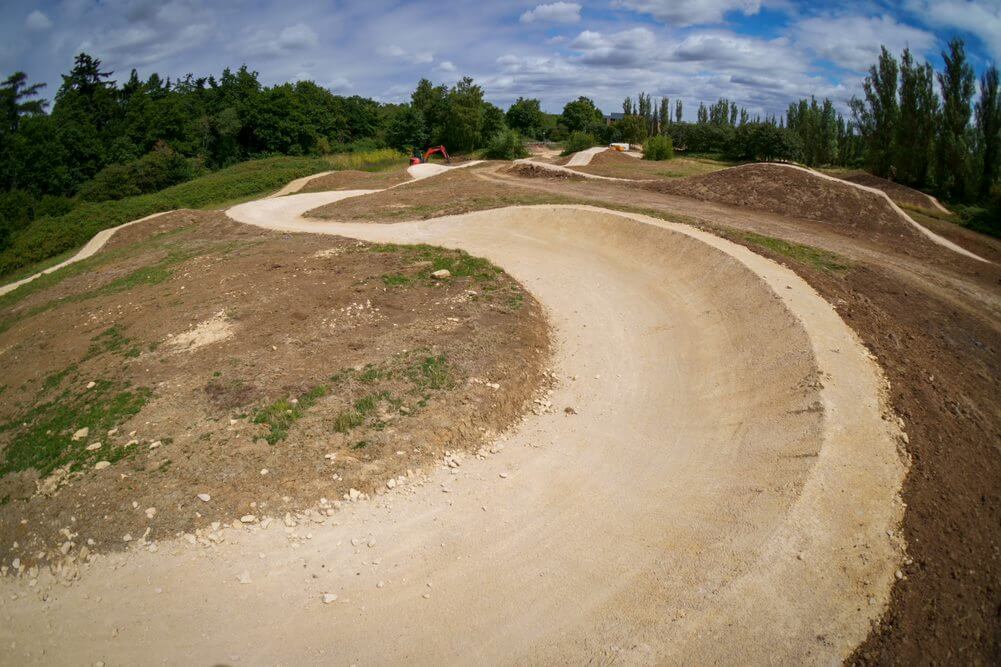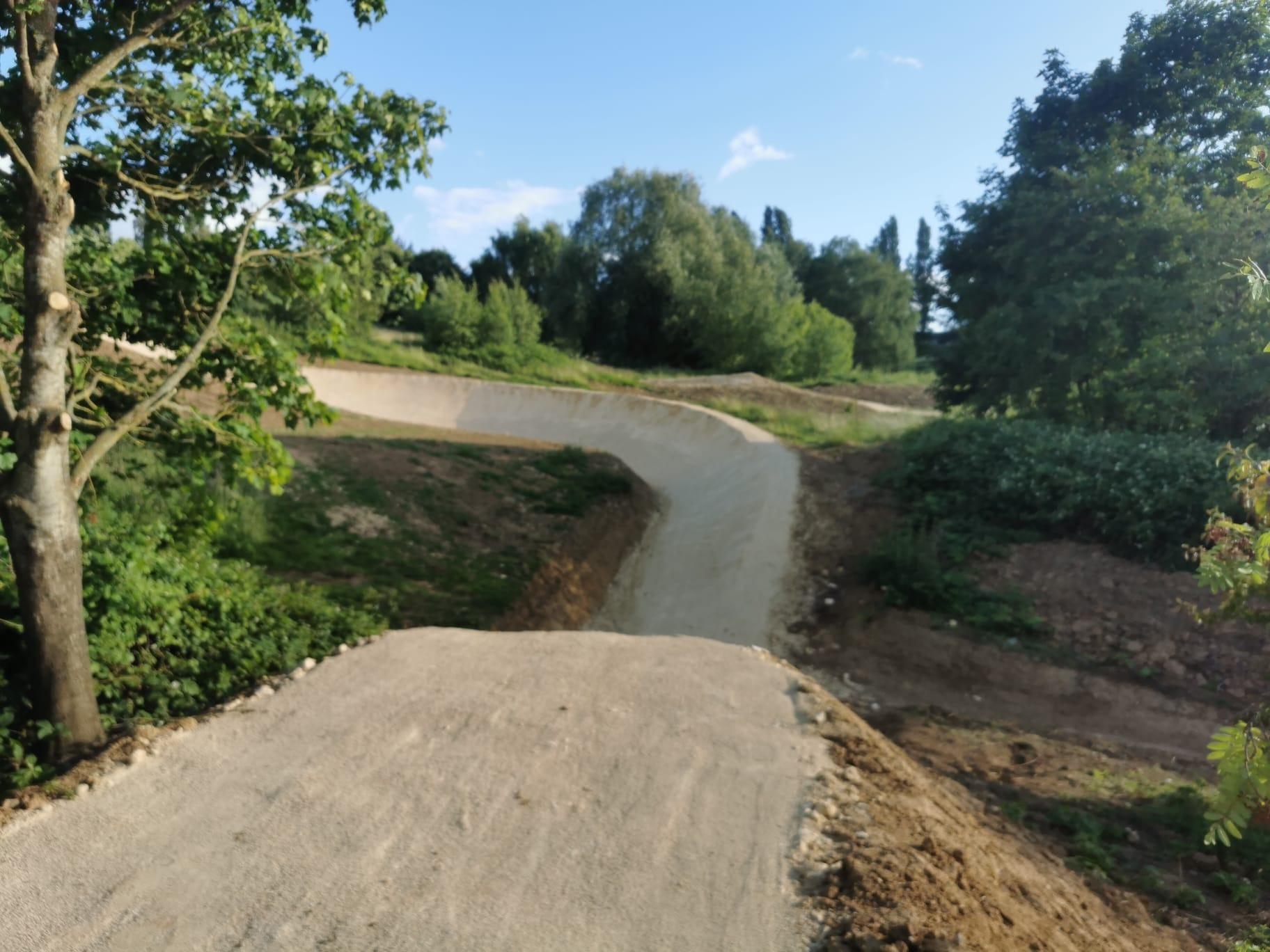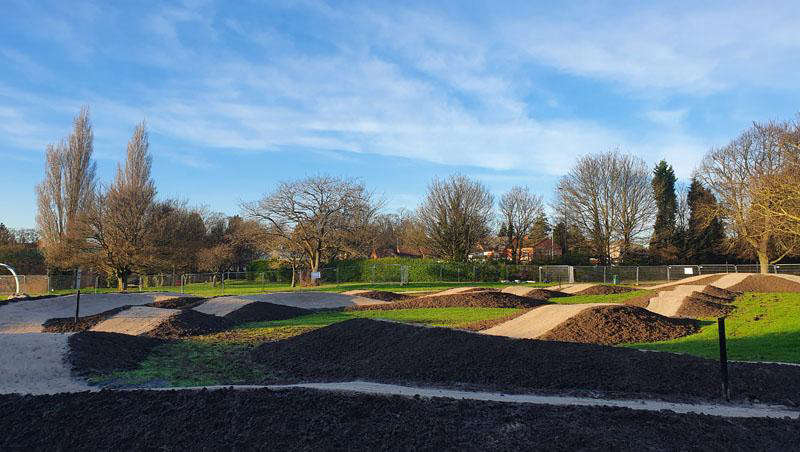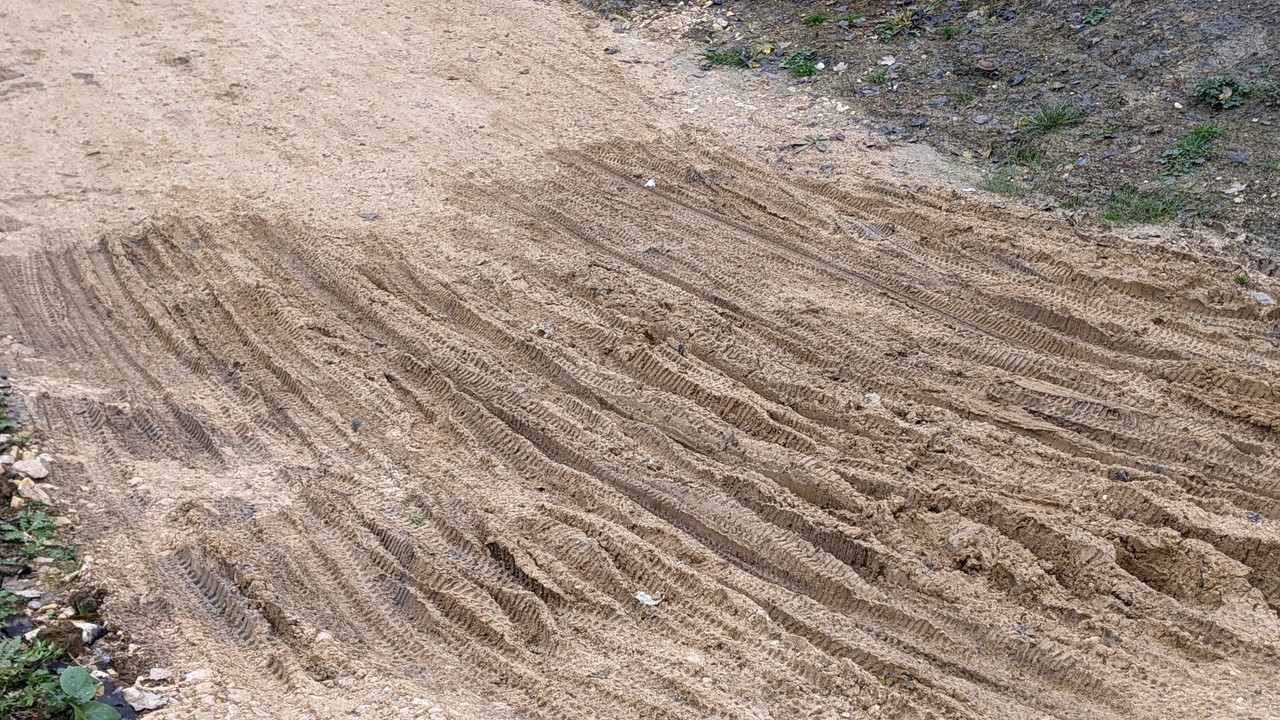- This topic has 50 replies, 24 voices, and was last updated 1 year ago by onewheelgood.
-
Bikepark surfacing. How durable?
-
kayak23Full MemberPosted 1 year ago
These days there are quite a few of these mini bike parks springing up around the country.
Most recently, Northampton has had one completed by On Track, and they are currently about a week into building another one in my town, Leamington Spa.
Really looking forward to it. Its basically going to be the same as Whistler right? 😉Northampton
They look beautiful when first finished. All flowing, sculpted dirt, with a strip of what I assume is crushed granite type surface.
But how durable is this stuff?
It would be such a shame if it gets all torn up quickly and no maintenance is done at these places.
There’s been a few of these now. Notably ones such as at Sheffield, Lady Cannings and Parkwood. How are they faring after a while?
Just interested in whether they’ll be around a while or if they’re all mouth and no trousers as it were.
NorthwindFull MemberPosted 1 year agoIt depends on a bunch of different things. Like, when we build a mainline trail at glentress, it’s armoured- we basically cut a ditch and then fill it with crushed stone and then whack the shit out of it. It’ll withstand a huge amount of traffic, even hard wearing traffic, and it’s also very weather resistant when combined with good drains- though frost heaves can occasionally cause a lot of damage. But it’s a ton of work and not impervious. It’s also relatively hard to fix if it goes wrong- since you can’t just patch it, you need to basically integrate a new section into the trail, much like a proper pothole repair in tarmac.
But there’s actually a really good argument for building things less indestructibly and just maintaining it more often.
TheBrickFree MemberPosted 1 year agocrushed granite
More likely crust concrete down to fines. It will slowly get washed away revealing the larger aggregate. The most common line though the middle will be worn the grass will slowly encroach.
This is given no maintenance. See any 89s BMX track by mid to late 90s.
The fines will almost certainly be washed away withi a few years but with some maintenance the rest can be avoided.
jacobffFull MemberPosted 1 year agoNot bike park surface but back when I used to ride swinley a lot the most weather resistant section was baby maker and that had fantastic water management. (Also great drainage due to sandy soil).
joebristolFull MemberPosted 1 year agoI helped a bit at Ashton Court with the volunteering of rebuilding new trails. They periodically redo sections / do regular ish maintenance on them.
They cut out the old trail and then laid down loads of what looked like sub base aggregate like you’d put under a patio. Then whacked plated it down loads and sculpted it all. I think they then lay down a finer dust on top and have to wait for it to settle etc. It has worn since they did it – but it’s had a huge amount of runs – I think I saw something about 47,000 individual laps on The Nova trail between Jan and July 2022.
So I think on an mtb trail it works well – I’m less convinced on a pump track. I have one near me that you could see eroding over time – and losing its flow. They have recently tarmaced it and it’s so much better – faster / flows nicer and will last a very long time with minimal / no maintenance.
The velo solutions pump tracks especially are lovely – like the ones in Bristol at Hillfields and Stockwood.
LankysprinterFree MemberPosted 1 year agoI spent the afternoon with Farmer John yesterday as he’s helping rebuild our local track in Marple.
His view is build it well and they need less maintenance, manage the water well is the key, maybe every 12 months you do a brief top up of surface material in key spots but more importantly you clear all your drains, cut back undergrowth to let light in etc.
There is a trail maintenance course being run at Llandegla for people who look after these sort of places and John is hoping to host one at his centre in Marple for all the local trail centres, pump tracks etc that have sprung up.
Look at Ride Sheffield for the model of how to sustain trails, maybe set up your own local trail support group?WorldClassAccidentFree MemberPosted 1 year agoThey are in the process of surfacing a few of the trails at Southampton Bike Park at the moment. Big aggravate whacked underneath and then a coat of fine in top.
Apparently the clay in the aggregates should bind it together but they said they would leave us a gap of each type to do running repairs as required.
We deliberation chose not to surface all trails so we can modify and maintain them easily in the future. Hoping that the surfaces ones are weather proof, durable and repairable though as I can’t imagine the council ever returning to do any more work*.*we didn’t ask for this work to be done but they got a grant and needed to spend it so we had little choice but to pay along. Most of the money seems to have been wasted in meetings, consultancy, surveys and a fence on two sides of the park to separate it from a cricket pitch and a cycle path.
kayak23Full MemberPosted 1 year agoI helped a bit at Ashton Court with the volunteering of rebuilding new trails. They periodically redo sections / do regular ish maintenance on them.
I rode them a few weeks back actually.
I can imagine they do get a crazy amount of traffic. They were rough in places but mostly pretty good.maybe set up your own local trail support group?
Yes I think this is definitely a good idea. I imagine the local club will be good for that as they were instrumental in getting it built in the first place.
We deliberation chose not to surface all trails so we can modify and maintain them easily in the future. Hoping that the surfaces ones are weather proof, durable and repairable though as I can’t imagine the council ever returning to do any more work*.
Yeah, good approach. I can’t imagine the council taking too much interest ongoing so a volunteer group is the way to go.
I imagine there’ll be some red tape to negotiate before any work can be done but I’m really hoping that it gets looked after.NorthwindFull MemberPosted 1 year agojoebristol
Full MemberSo I think on an mtb trail it works well – I’m less convinced on a pump track. I have one near me that you could see eroding over time – and losing its flow. They have recently tarmaced it and it’s so much better – faster / flows nicer and will last a very long time with minimal / no maintenance
Yeah, as long as the builder really knows what they’re doing since it’s obviously very permanent- the nice thing about dirt is you can always reshape it, but that’s most important for jumps.
(after drainage, jumps are often the biggest problem ime- a hardened trail can lose a huge amount of material without it being an issue but a jump can lose its shape really, really quickly on a multiuse trail. It’s why trail centre jumps are almost always of the “vague lump” style without any real shape, they don’t work anything like as well, but anyone can ride over them and they don’t need to be the perfect shape. And frankly, you need to be <good> to correctly build a jump for the masses, you need to second guess the speed people will approach, work out the visibility, all that before you even lift a shovel. I can’t, I can hit fings wiv shuvulz.
sharkattackFull MemberPosted 1 year agoIts basically going to be the same as Whistler right? 😉
Depends. What’s the nightlife like?
zerocoolFull MemberPosted 1 year ago@joebristol – I keep meaning to get up to Hillfields with the kids (4 yrs old) any idea what the parking is like? We normally use the pumptrack at Little Stoke Park as it has a big free car park and a bit nearer to my house. Same with Stockwood, what’s the parking like? I know the smaller track at Lyde Green is crap for parking and also probably a mud bath by now.
joebristolFull MemberPosted 1 year agoThe lyde green track is crap – you have a few jumps slightly downhill then you have to pedal back up with no flow at all.
Hillfields is fun – it has a small top bowl that’s pure pump – then a slightly downhill flow but that’s quite fast.
Parking is just on the road – loads of residential roads all round. It’s not the best area, but it’s a lot better than the Hartcliffe one!
Stockwood is road parking again – shouldn’t be too bad getting parked. I got right outside the park bit last time. Really fun – the bowl is a little bigger and faster than hillfields. Then there’s a massive jump track down the hill – on my bmx jumping scares me so I haven’t really committed to the jumps properly yet
LankysprinterFree MemberPosted 1 year agoBest way round the red tape is create a community group or join with the existing bike club, then register with the council in the way the friends of park groups do- your local councillor will have contacts. You can then register work days, do basic maintenance etc on their land with their insurance in case anyone has an accident.
For our park it’s really simple- one page risk assessment that’s always the same, register the event with a half page form, then get down and start working. To use power tools there’s a basic council course people can do too.4ndyhFull MemberPosted 1 year agoNorthamptonian here… lucky enough to live about a 10 min ride from the bike park, so it’s my local.
The trails have been designed/built to be ‘all-weather’… don’t know the exact composition underneath but it looks like aggregate with some sort of fine fill/binder course on top. It actually benefits from a bit of rain to help bind the surface together… I was one of the fortunate few who got to test-ride the park the weekend before it opened and it was very loose/dusty before we had some rain to damp it all down some more.
It’s been pretty hard-wearing so far but not indestructible; the park has been ridiculously popular & busy since it opened and riders on the local NMBG page are now reporting some wear on some of the berms and landings. However the bike park has wardens and a trail maintenance crew to do regular trail inspections and keep on top of any wear/damage they find.
kayak23Full MemberPosted 1 year agoBikepark surfacing. How durable?
In answer to my own question, not durable enough seemingly. 😐
Popped down to Northampton bike park today to have a razz. To be fair to it, its had a huge amount of use and the weather hasn’t been great, but yeah, I was pretty disappointed in just how knackered parts of the track were really. It hasn’t really held up that well unfortunately.
Thought it would be more hardpack and able to withstand the weather and traffic a bit better.
Most of the deep, muddy rutted sections are coming into or out of jumps so things get pretty sketchy.
You can see the section in the below image, in the landing of the biggest jump in the above image.dc1988Full MemberPosted 1 year agoIs it just a few places or enough to spoil a lot of the riding? I’m pretty close and have been meaning to visit but might be best to wait until spring
kayak23Full MemberPosted 1 year agoIt’s quite a few places. One of the black trails is closed off, presumably because of this.
Might be worth a visit if you’re fairly close. Wouldn’t want to put you off. It’s certainly a great facility. I’m just quite surprised about how worn out it is so quickly.
The main reason I went is because the same company are currently building another in my town and having looked at how they surface the trails, I was interested in how well they stand up to use.
Seemingly not that well 😐
onewheelgoodFull MemberPosted 1 year ago@kayak23 I had a wander round Newbold on Thursday on my way back from a bit of Wildlife Trust work at Leam Valley. It looks a lot more extensive than I was expecting, and my first thought was ‘I really hope they’ve kept some budget back for maintenance’.
With regard to your pics of the state of the Northampton trail, I don’t think you’d get it muddying up like that unless you had standing water – as someone said above, it’s all down to water management. So it’s a profiling issue rather than a surfacing one, although that profile issue might be caused by the erosive effect of the landing zone.
kayak23Full MemberPosted 1 year agoYeah I agree.
I mean drainage though is on the first page of the trail builders book so it’s surprising that it’s a problem when you’d think that, that would be forefront in the way that any trail is built by a specialist company.It’s basically one of the first considerations for building trails in the UK.
Or do they tend to build it and see what happens?
It worries me a bit as it took such a lot of fight to get this built in Leam and it would be a shame to give the enthusiastically opposed dog operators any ammunition to point out that it shouldn’t have been done.
Hate to be a bit negative about such positive things for our communities but it kind of feels like having something that’s a mess will be worse than when we had nothing.
It’s taken a lot to get things like these built so they really need to stand up to usage. 😐colournoiseFull MemberPosted 1 year agoShame. I’m only 45 minutes away from NBP but still haven’t got round to visit.
Don’t think I’ll bother until they sort that. I can ride muddy rutted trails from my door…
JonEdwardsFree MemberPosted 1 year agoThere’s always some bit of a trail that doesn’t work first time round. Hopefully the land managers have got a maintenance contract in place with the builders to come and snag stuff like that.
Its easy enough to say “always think drainage”, but a) unless you spend a loooong time assessing the site over multiple seasons first, you can’t actually do more than guess; b) the act of building changes stuff anyway as you disturb the ground.
Equally, it might be less well compacted than planned, the original ground underneath may be collapsing, there might be materials issues – we had problems at Lady Cannings – all built using found material on site, but a couple of patches had a much higher clay content than the rest so turned awful in winter.
The steeper the site, the easier drainage is as the water always wants to go downhill. That looks quite flat, so its going to be much easier for water to pool and much harder to get rid of it.
JonEdwardsFree MemberPosted 1 year agoNotably ones such as at Sheffield, Lady Cannings and Parkwood. How are they faring after a while?
To follow this up from the initial post.
Parkwood I don’t ride much (wrong side of town), but I ran the leaf blower over it a couple of week back in the pissing rain, and even though some of it was a river, the trail surface was absolutely rock hard. Its a steepish hill side, so drains pretty well.That’s 10 years old now, and I believe is getting some new stuff soon. Not sure how much use it gets as its pretty tight and twisty and a bit “xc” for a lot of riders and modern bikes these days
Cannings has been a victim of its own success. Its gets SOO much use. Blue Steel (opened in 2015) is most of the way through a revamp driven by Ride Sheffield and volunteers and part funded by the Santa Cruz Paydirt fund. The newest bits reopened on Friday, and as current, it rides pretty damn nicely. Cooking On Gas (2017) is battered. Can’t remember the last time I rode it. Its too big a project for us to do piecemeal, so if anyone has a spare £40k down the back of the sofa….? So you kind of get 5 or 6 years out of a built mtb trail before it needs a proper refurb. Jump lines will need a lot more work, as they’re a load of rubbish as soon as the lips get mashed.
NorthwindFull MemberPosted 1 year agoI think what you’re seeing there is basically “build it then fix it”- if 95% of the trail holds together and 5% needs fixed, that’s still a pretty good ratio and probably better than putting twice as much work into the whole trail in the first place to try and achieve 100%.
This way, they can come back in, reshape and resurface those rapidly worn bits to be much stronger, fix unexpected wear spots or drainage, etc. It looks bad but it’s an efficient way to build. Basically you can build a ton more trail on the “build then fix” approach than you can with the “build it all super strong” approach that we’ve traditionally used.
jediFull MemberPosted 1 year agoI use a 1ft deep top coat of type 1 motorway hardcore .now my place runs well in all weather
NorthwindFull MemberPosted 1 year agoYeah, that’s pretty much how we used to build everything. ChrisL put it beautifully, dig down til we’ve made something that looks like a brilliant trail, then bury it. But it’s the multiplier effect- how much longer it’d take and how much more expensive it’d be to build all that yellow stuff up there in grey instead. Or, realistically, they’d probably have… I dunno, 20% as many trails? Or, no trails at all most likely of all.
zerocoolFull MemberPosted 1 year agoI guess this is one of the reasons Velosolutions and Clark & Kent recommend building things like this out of tarmac.
zerocoolFull MemberPosted 1 year agoImm sure they’ll come back, tidy it up and maybe reinforce the bits that get trashed quickly.
finephillyFree MemberPosted 1 year agoThe local trail to me is still usable, but fairly well beaten up after a couple of years light use. That was dug out a few inches and an MOT-type base with a gravel surface packed on top.
I think the key is really digging down deep and building each layer up like a roman road. The downside is that means it can’t be changed so easily. I would say stuff like the Northampton track (if it’s just packed soil with surface dust) will need resurfacing and holes filling in after a year.
the difficulty with drainage is predicting how water runs off the trail, especially with large jumps on flat land.
jivehoneyjiveFree MemberPosted 1 year agoThis is a circumstance where I could say a great deal more; but I’m not really sure if I should…
jivehoneyjiveFree MemberPosted 1 year agoWonder if Rob has got that bowser he was on about yet?
Would’ve thought lessons had been learnt after Rostrevor…
Whacking trails that are too dry is not only a waste of time and energy that can cause significant damage to the trail, it doesn’t do much good to the operator’s hands either
branesFull MemberPosted 1 year agoWhacking trails that are too dry is not only a waste of time and energy that can cause significant damage to the trail, it doesn’t do much good to the operator’s hands either
Well that shouldn’t be a problem in Leamington then hopefully. It pissed down most of November.
seriousrikkFull MemberPosted 1 year agoI was at Northampton a few weeks back with a group – this was pretty much the saturday after the rain stopped.
That section at the top of Blue Nun was so horrible and gloopy it was hilarious – but yea, not ideal.
We actually got chatting to a guy who turned out to be one of the main volunteers who got the place going – sound bloke. Turns out they are getting the contractors back in to do some fixing and rework some sections to improve the drainage. There are also a few parts that are earmarked for improvement too. Looking forward to returning when that is done.
finephillyFree MemberPosted 1 year agoI suppose that’s the thing with trails built using ‘one-off’ funding. There is X amount to build them, but nothing for maintenance. Who knows what it costs anyway? It depends on variables like weather, number of riders.
bobbyspanglesFull MemberPosted 1 year agoFingers crossed Newbold will hold up but when i went last Northants was looking battered, not just the trails-the flat areas to entrance. I guess it’s a victim of its own success. Happy for trails to be accessible for all though.
Leam trails look ace, the skills area near to the Newbold will be crackingjivehoneyjiveFree MemberPosted 1 year agoWell that shouldn’t be a problem in Leamington then hopefully. It pissed down most of November.
Whacking excessively wet trails, though still not ideal (especially when the whacker plate has a dodgy belt, due to poor maintenance, despite repeated reassurances and months in which the responsible party could have checked all equipment was in good order) is at least more likely to bind the materials, helping to seal against saturation; any major flaws can be fluffed up again with a BTR (or similar meaty rake) and reshaped.
This luxury is not available with over dry trails, which remain vulnerable to the elements, be that wind blowing the fines away, leaving a gravelly surface, or water saturating the material in such a way that it becomes a mushy paste, perfect for ruts which then hold further surface water.
kayak23Full MemberPosted 1 year agothe skills area near to the Newbold (pub) will be cracking
Especially after a few beers. 🤣
Whacking excessively wet trails, though still not ideal (especially when the whacker plate has a dodgy belt, due to poor maintenance, despite repeated reassurances and months in which the responsible party could have checked all equipment was in good order)
You going to elaborate? Clearly you have skin in the game, as it were.
You must be logged in to reply to this topic.





